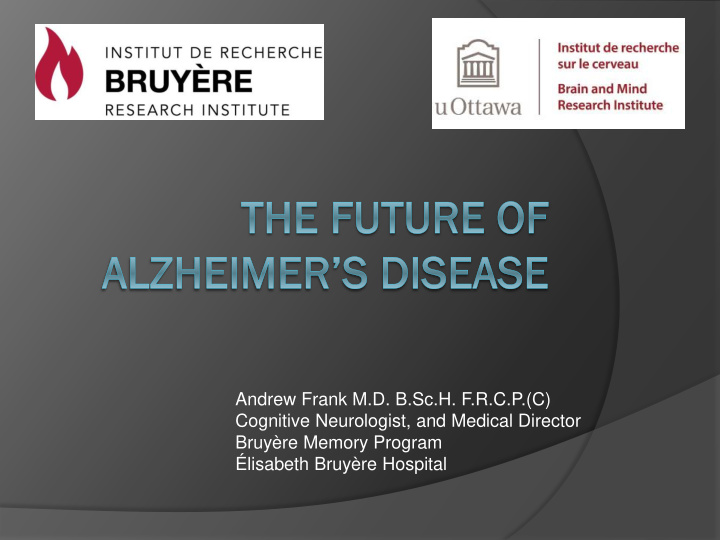



Andrew Frank M.D. B.Sc.H. F.R.C.P.(C) Cognitive Neurologist, and Medical Director Bruyère Memory Program Élisabeth Bruyère Hospital
Memory: What is normal? Some degree of memory loss may be normal as someone gets older Having more difficulty with people’s names Forgetting why one has entered a room Normal for answer to these questions to come later, after a few minutes, or sometimes hours Memory is intact, but somewhat slower to respond
Memory: What is not normal? Forgetting important details from recent conversations or events Repeating questions or statements within the same day or conversation, without recollection of saying the same thing before Memory loss which other people notice, when someone does not notice it in themselves
Memory: What is not normal? Memory loss which begins to impair independent daily functioning Taking medications properly Managing bills correctly Shopping Cooking / Cleaning Driving a car safely Dressing Hygiene
What is Dementia? Dementia is a medical term which applies to memory loss which is significant enough to impair someone’s daily independent functioning Mild Dementia Some help required with bills and medications Moderate Dementia Some help required with dressing and hygiene Severe Dementia Help required with all daily functioning
What is Alzheimer’s disease (AD)? Alzheimer’s disease is a build -up of specific proteins in the brain (amyloid and tau), which causes the brain to lose recent memories, and eventually other thinking functions Alzheimer’s disease is the most common cause of Dementia Other causes: Stroke, Parkinson’s disease, Head Injury
Dementia and Alzheimer’s Alzheimer’s disease is the cause Dementia is the effect
How does Alzheimer’s disease progress? Early Mild-to-moderate Severe Symptoms 25 Diagnosis M 20 M Loss of functional independence 15 S Behavioral problems E 10 Nursing home placement 5 Death 0 1 2 3 4 5 6 7 8 9 Time (years) Feldman, H. and Gracon, S. Clinical Diagnosis and Management of Alzheimer’s Disease. 1996:239-253.
Prevalence of AD Aged 65: 2.5% Aged 70: 5% Aged 75: 10% Aged 80: 20% Aged 85: 40% Doubling of prevalence with every 5 years of age after age 65
The Threat of Alzheimer’s ◼ US prevalence 4.5 million (2000) → 13.2 million (2050) Hebert et al. Arch Neurol. 2003 Aug;60(8):1119-22.
The Threat of Alzheimer’s In Canada Today: Estimated 564,000 Canadians have Alzheimer's or a related dementia In 15 years: Estimated 937,000 Canadians will have Alzheimer's or a related dementia Economic cost of care currently $10.4 billion annually Alzheimer Society of Canada
Dr. Alzheimer’s disease (AD) 1906 Tau Tangles Amyloid Plaques
The Creation of Amyloid Amyloid (A b) Fragment
The Toxic Effect of Amyloid Amyloid Oligomers Amyloid (A b) Fragments Amyloid Plaques Brain Toxicity
Visualizing Alzheimer’s disease (AD) PET scan with Pittsburgh compound-B (injected intravenously before scan) allows amyloid protein to be visualized
Tau Imaging AV-1451 Tau-PET tracer (flortaucipir)
Is there any treatment for Alzheimer’s? Mild Symptom treatment Cholinesterase Inhibitors ○ Aricept/donepezil ○ Reminyl/galantamine ○ Exelon/rivastigmine Available as a transdermal (skin) patch Moderate Symptom treatment Ebixa/memantine
Can Alzheimer’s disease be prevented? Control “vascular” (blood vessel) risk factors High blood pressure (hypertension) High cholesterol High blood sugar / Diabetes Stopping smoking Loss of excess weight Mental and Physical exercises Social Involvement Balanced Diet
Is there hope for new treatments for Alzheimer’s disease? Huge effort worldwide to discover new treatment Now attempting to remove amyloid and tau build- up which causes Alzheimer’s disease
Anti-Amyloid Antibody Intravenous Anti-Amyloid Antibody Phase 3 studies been disappointing
Anti-Tau Treatment Intravenous Anti-Tau Antibodies Prevents clumping of tau protein tangles Phase 2 study underway at Bruyere Memory Program
Also Under Investigation Secretase Inhibitors Slows production of amyloid Phase 3 studies now underway PBT-2 Captures copper and zinc in the brain, preventing clumping of amyloid Nerve Growth Factors Promotes regrowth of neurons Stem Cell Research
Also Under Investigation Early detection of cognitive impairment via computerized cognitive testing At-home cognitive testing via tablet gaming In-home monitoring for safer and more sustainable home living with dementia
Working Together
Bruyère Memory Program Located at Élisabeth Bruyère Hospital in Ottawa OHIP covered Referral from physician required Memory testing performed by nurse or neuropsychologist Appointment with memory- specialized physician arranged to review results
Conclusions Dementia due to Alzheimer’s disease is a threat to individuals, their families, and to society as a whole, now and over the next generation
Conclusions Current treatments, such as cholinesterase inhibitors and memantine, have a modest cognitive benefit, and may delay time to serious disability or time to placement in a nursing home Management of vascular risk factors, and a healthy lifestyle, are recommended
Conclusions Treatment of the underlying amyloid and tau protein deposition in Alzheimer’s disease is being tested New treatment options may be available within the next 3 years
Recommend
More recommend